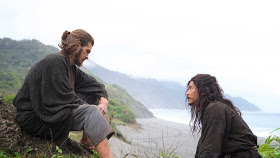Martin Scorsese struggled for decades to adapt Shusaku Endo's 1966 novel Silence into a film, and the result is a dark, brutal, and powerful masterpiece about a man's struggle with his faith, in the face of almost unbearable suffering and persecution. Although I am not a particularly religious person, what I connected with in Silence (2016) is its depiction of someone whose faith in a transcendent force guides his every thought and action. This force can be "Jesus," or "Buddha," or "Allah," but what Scorsese is trying to portray is a belief in a higher force that allows us to transcend the darker, more destructive side of human nature.
Set in the 17th century, Silence is the story of a mission by Portuguese Jesuit priests Sebastiao Rodrigues (Andrew Garfield) and Francisco Garupe (Adam Driver) to find Father Cristovao Ferreira (Liam Neeson) in Japan, who has been rumored to have renounced his faith after being tortured. Although they know that they are entering a country which at the time was targeting Christians with violent religious persecution, the two Jesuit priests nevertheless carry out their mission without hesitation. In the process, the priests befriend a group of Japanese Christians, who practice their faith in secret under fear of being tortured and even killed. Eventually, the two priests are captured by the Japanese, and Father Rodrigues' faith in a higher power is put to the ultimate test.
While the leads of Silence are the two Jesuit priests, Scorsese also gives equal time to the many Japanese actors in the film. The standouts are Issey Ogata as the cruel and manipulative Inoue Masahige, Shinya Tsukamoto as the passionately devout Christian Mokichi, and Yosuke Kubozuka as the conniving and self-centered Kichijiro. Shinya Tsukamoto gives a particularly powerful performance as a long-suffering Christian who is able to maintain his faith even under the cruelest forms of punishment. Indeed, Silence is all about the struggle to maintain one's sanity and strength in the face of overwhelming brutality.
Filmed in the verdant landscape of Taiwan, the natural scenery as shot by cinematographer Rodrigo Prieto is gorgeously rendered. Scorsese contrasts the beauty of nature with the cruelty of the human world, and he doesn't flinch from showing us the bloody and brutal extents to which the Japanese inquisitors will go to torture and persecute the Jesuits priests and their fellow Japanese converts. Silence continues Scorsese's examination of religious persecution, which he explored before in The Last Temptation of Christ and Kundun. In this sense, Silence completes Scorsese's spiritual trilogy of films, with the connecting thread between the three films being a protagonist who struggles with keeping his faith in a world where the most atrocious and inhumane forms of destruction and violence exists.
Although Silence is on its surface a religious film, its message of compassion for those who are suffering is a universal one. Rodrigues is not only seeking to maintain his faith in a society that has outlawed it as a symbol of Western imperialism and control; he is ultimately seeking to transcend the cruelty and brutality of his time by not giving into his darker impulses to violently rebel against or physically attack those who are persecuting him. Rodrigues is able to do this by never letting go of his faith in a higher power, which he views as a positive symbol of peace amidst a world filled with violence.
Throughout the film, Rodrigues views his mission as one of bringing peace and love to those who are less fortunate than him; hence his willingness to take in the suffering Japanese villagers at the beginning of the film and allow them to practice their faith in peace. If we take away the subject matter of Christianity and religion, we can also see Rodrigues as someone who views it as his life mission to be compassionate to all.
Indeed, throughout the film, Scorsese contrasts the more peaceful actions of Rodrigues with those of the inquisitors. After one of the Japanese prisoners is horrifically beheaded for refusing to renounce his faith, Rodrigues gives forgiveness to another Japanese prisoner who is clearly a scoundrel and a liar. Rodrigues sees the goodness in everyone as a guiding force in his life, while the inquisitors use violence and torture to maintain their worldview, much like the outlaw criminals in Scorsese's gangster films.
The use of physical forms of religious belief is displayed throughout Silence, in the form of Bressonian-like close-ups of hands in prayer, and various paintings and likenesses of Christ. These physical manifestations of religious iconography are presented as forbidden symbols of spiritual expression in a wider society that forbids them. Eventually, Rodrigues is forced to renounce his Christianity by stepping directly onto a likeness of Christ in an act of apostasy. Interestingly enough, Rodrigues' struggles to communicate with God seem to stop after he steps on this physical form of religion. Scorsese is showing how Rodrigues is finally able to transcend the outer realm of belief and internalize it into a deeper, spiritual inner world.
Ultimately, Silence is a film about a man who struggles to maintain his faith in a benevolent, higher power amidst a world filled with death and destruction. Scorsese shows us this struggle in masterfully directed scenes of betrayal and spiritual turmoil, but throughout Silence is a deep, unyielding belief in the goodness of humankind. Without giving anything away, the last image of Silence shows Rodrigues literally holding onto a symbol of compassion and love, long after he has struggled with being able to outwardly reveal his faith in God. Scorsese's Silence shows us how even in the darkest of times, we should never let go of our better selves.





No comments:
Post a Comment